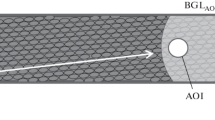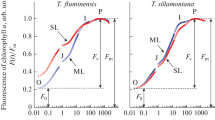Abstract
Chlorella was used to study the effects of dehydration on photosynthetic activities. The use of unicellular green algae assured that the extent of dehydration was uniform throughout the whole cell population during the course of desiccation. Changes in the activities of the cells were monitored by measurements of fluorescence induction kinetics. It was found that inhibition of most of the photosynthetic activities started at a similar level of cellular water content. They included CO2 fixation, photochemical activity of Photosystem II and electron transport through Photosystem I. The blockage of electron flow through Photosystem I was complete and the whole transition occurred within a relative short time of dehydration. On the other hand, the suppression of Photosystem II activity was incomplete and the transition took a longer time of dehydration. Upon rehydration, the inhibition of Photosystem II activity was fully reversible when samples were in the middle of the transition, but was not thereafter. The electron transport through Photosystem I was also reversible during the transition, but was only partially afterward.
Similar content being viewed by others
Abbreviations
- DCMU:
-
3-(3′,4′-dichlorophenyl)-1,1-dimethyl urea
- Fm :
-
maximum fluorescence yield
- F0 :
-
non-variable fluorescence level emitted when all PS II centers are open
- Fv :
-
variable part of fluorescence
- PS:
-
photosystem
- QA :
-
primary quinone acceptor of Photosystem II
References
Boyer JS (1976) Water deficits and photosynthesis. In: Koziowski TT (ed) Water Deficits and Plant Growth, Vol IV, pp 153–190. Academic Press, New York
Boyer JS and Younis HM (1984) Molecular aspects of photosynthesis at low leaf water potential. In: Sybesma C (ed) Advances in Photosynthesis Research, Vol IV, pp 359–365. Martinus Nijhoff/Dr W Junk Publishers, The Hague
Bukhov NG, Sabat SC and Mohanty P (1989) Sequential loss of photosynthetic functions during leaf desiccation as monitored by chlorophyll fluorescence transient. Plant Cell Physiol 30: 393–398
Chen PC and Lorenzen H (1986) Changes in the productivity and nuclear divisions in synchronous Chlorella and circadian rhythm. Plant Cell Physiol 27: 1423–1427
Govindjee and Papageorgiou G (1971) Chlorophyll fluorescence and photosynthesis: Fluorescence transient. In: Giese AC (ed) Photobiology, Vol 6, pp 1–50, Academic Press, New York
Govindjee and Satoh K (1986) Fluorescence properties of chlorophyll b- and chlorophyll c-containing algae. In: Govindjee, Amesz J and Fork DC (eds) Light Emission by Plants and Bacteria, pp 497–537. Academic Press, New York
Govindjee, Downton WJS, Fork DC and Armond PA (1981) Chlorophyll a fluorescence transient as an indicator of water potential of leaves. Plant Sci Lett 20: 191–194
Gupta AS and Berkowitz GA (1988) Chloroplast osmotic adjustment and water stress effects on photosynthesis. Plant Physiol 88: 200–206
Kaiser WM, Kaiser G, Prachuab PK, Wildman SG and Heber U (1981) Photosynthesis under osmotic stress. Inhibition of photosynthesis of intact chloroplasts, protoplasts and leaf slices at high osmotic potentials. Planta 153: 416–422
Matorin DN, Ortoidze TV, Nikolaev GM, Venediktov PS and Rubin AB (1982) Effects of dehydration on electron transport activity in chloroplasts. Photosynthetica 16: 226–233
Mohanty P and Boyer JS (1976) Chloroplast response to low leaf water potential: Quantum yield is reduced. Plant Physiol 57: 704–709
Satoh K (1981) Fluorescence induction and activity of ferredoxin-NADP+ reductase in Bryopsis chloroplasts. Biochim Biophys Acta 638: 327–331
Schreiber U (1986) Detection of rapid induction kinetics with a new type of high-frequency modulated chlorophyll fluorometer. Photosynth Res 9: 261–272
Sivak MN and Walker DA (1985) Chlorophyll a fluorescence: Can it shed light on fundamental questions in photosynthetic carbon dioxide fixation? Plant Cell Environ 8: 439–448
vanRensburg L and Kruger GHJ (1993) Differential inhibition of photosynthesis (in vivo and in vitro), and changes in chlorophyll A fluorescence induction kinetics of four tobacco cultivars under drought stress. J Plant Physiol 141: 357–365
Wiltens J, Schreiber U and Vidaver W (1978) Chlorophyll fluorescence induction: An indicator of photosynthetic activity in marine algae undergoing desiccation. Can J Bot 56: 2787–2794
Author information
Authors and Affiliations
Rights and permissions
About this article
Cite this article
Chen, YH., Hsu, BD. Effects of dehydration on the electron transport of Chlorella. An in vivo fluorescence study. Photosynth Res 46, 295–299 (1995). https://doi.org/10.1007/BF00020443
Received:
Accepted:
Issue Date:
DOI: https://doi.org/10.1007/BF00020443




